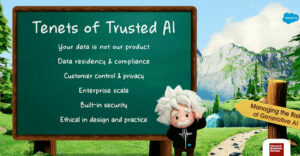
‘Tis the Season. And it’s better to give than to receive. And you’d better watch out.
Besides being Christmas gibberish, those statements apply neatly to CRM. It’s always the season to think about improving how your employees use CRM. It’s better to give them tools that reward them for using them instead of making CRM a way to receive statistics about their performance. And you had better watch out — because the minute you stop thinking about improving your CRM approach is the minute your competitors begin to gain on you.
Since it is a season of giving, here are five things you can give your users to help them deliver better results with CRM in sales, service and marketing.
1. A CRM system that everyone finds easy-to-use
The interface has been cited time and time again as a critical aspect of driving user adoption. That’s never been more true. Within businesses, more people are being required to interface with CRM, which means that there’s often less training and less time for getting used to the feel of the software.
The key to that is to pay close attention not just to the basics of ease of use but to focus on ease of use for everyone in the organization. In other words, you want people with very different jobs not only to be able to use the same system, but also to be able to tailor the interface to their jobs — and to do so without help from IT.
2. Data that helps them do their jobs, not data that helps managers criticize their work
Sales guys often complain that CRM is merely a tool to help sales managers find things to complain about. While it is useful for examining trends, it should also provide real-time help to your sales people (and marketers and service personnel, for that matter).
Examine your CRM system closely, and look for features that can feed critical data to your staff as it’s discovered. If you can’t find those features, look around in the market for tools that integrate with CRM systems to feed them data on important customer activities — orders, website visits, responses to marketing initiatives, etc.
While your sales managers should still be able to get data on performance, your sales team should be able to give you feedback on the tools you provide them in return.
3. A way to incorporate social media into their jobs
Nothing is more frustrating than seeing or hearing things from customers that can impact your business, and then discovering your processes are so rigid that you can’t find a way to put that information to work. In many organizations, that’s the case: Social media haven’t been effectively integrated into marketing, sales and service processes, and so pearls of wisdom from customers are never strung together to improve things.
Social media (and it’s more sophisticated cousin social CRM) are out there on the horizon as tools for either you or your competitors, and you ignore them at your peril. At the very least, you need to find a way to tap into what your employees are discovering. That might mean technology, or it might mean a regular meeting with your staff.
4. Time to train
A lot of CRM implementations address specific problems — flagging sales, ineffective marketing, a problem with retention, and so on. The system is put in place, the problem is mitigated — and thinking about the capabilities of the system comes to a halt.
That’s a bad idea, because customers are always changing, and what you need in order to manage data about customers is always changing, too. If you provide staff with training on a system — not one-day “how to” training but something more in depth — then when circumstances change, they will have the power to change the way they use your CRM system in a more timely and more effective manner.
This should be an ongoing thing — as features are added by your vendor, your people should be brought up to date, so when those features are needed, they can be brought to bear immediately.
5. Integration with the whole business
Sales, marketing and service can’t do their jobs without interfacing with the rest of the business, but the front-office/back-office dichotomy often causes that interface to be inelegant and inefficient.
The reality is that in a modern business, the boundaries between front office and back office are blurring, and so a suite approach to CRM and back-office functions — or at least a lot of thinking about integration — is extremely useful to make sure your customer-facing employees don’t face their biggest battles within the company.
In businesses whose customers require rapid delivery or whose merchandise is perishable, this is an obvious need: If the warehouse can’t communicate what’s ready to ship, sales can’t guarantee what it promises customers.
With customer expectations on the rise, that requirement is creeping into more vertical markets all the time. Building a business ecosystem that readies you for this is a gift that keeps on giving.
CRM Buyer columnist Chris Bucholtz blogs about CRM at Forecasting Clouds. He has been a technology journalist for 15 years and has immersed himself in the world of CRM since 2006. When he’s not wearing his business and technology geek hat, he’s wearing his airplane geek hat; he’s written two books on World War II aviation, and his next two are slated for publication in 2010.






















































